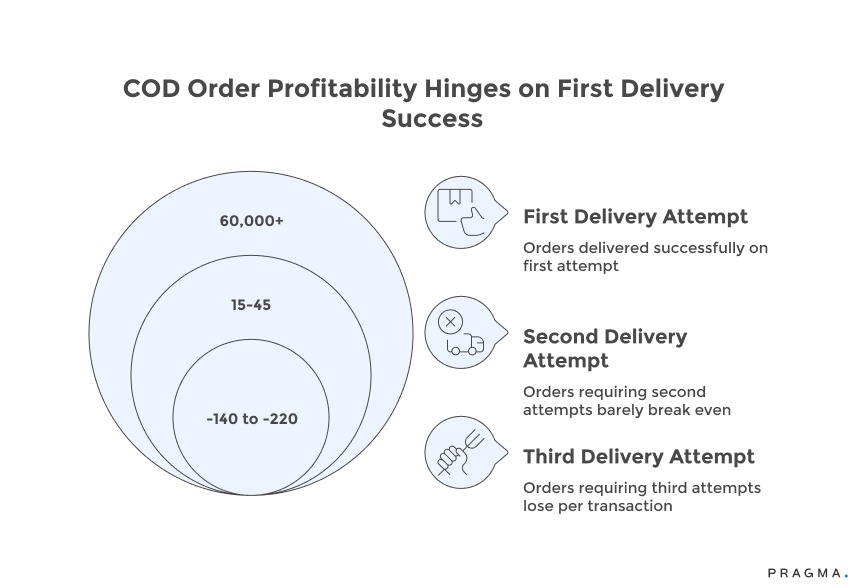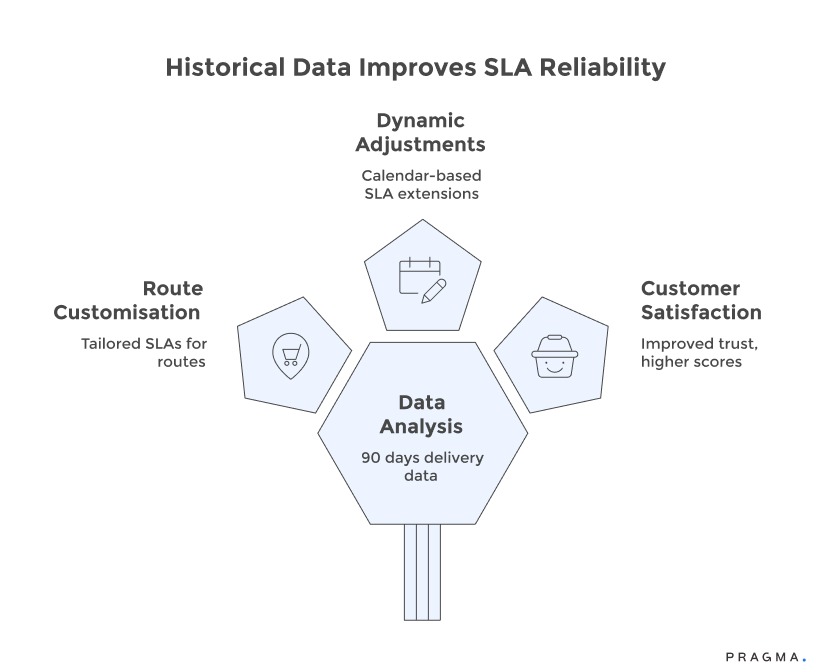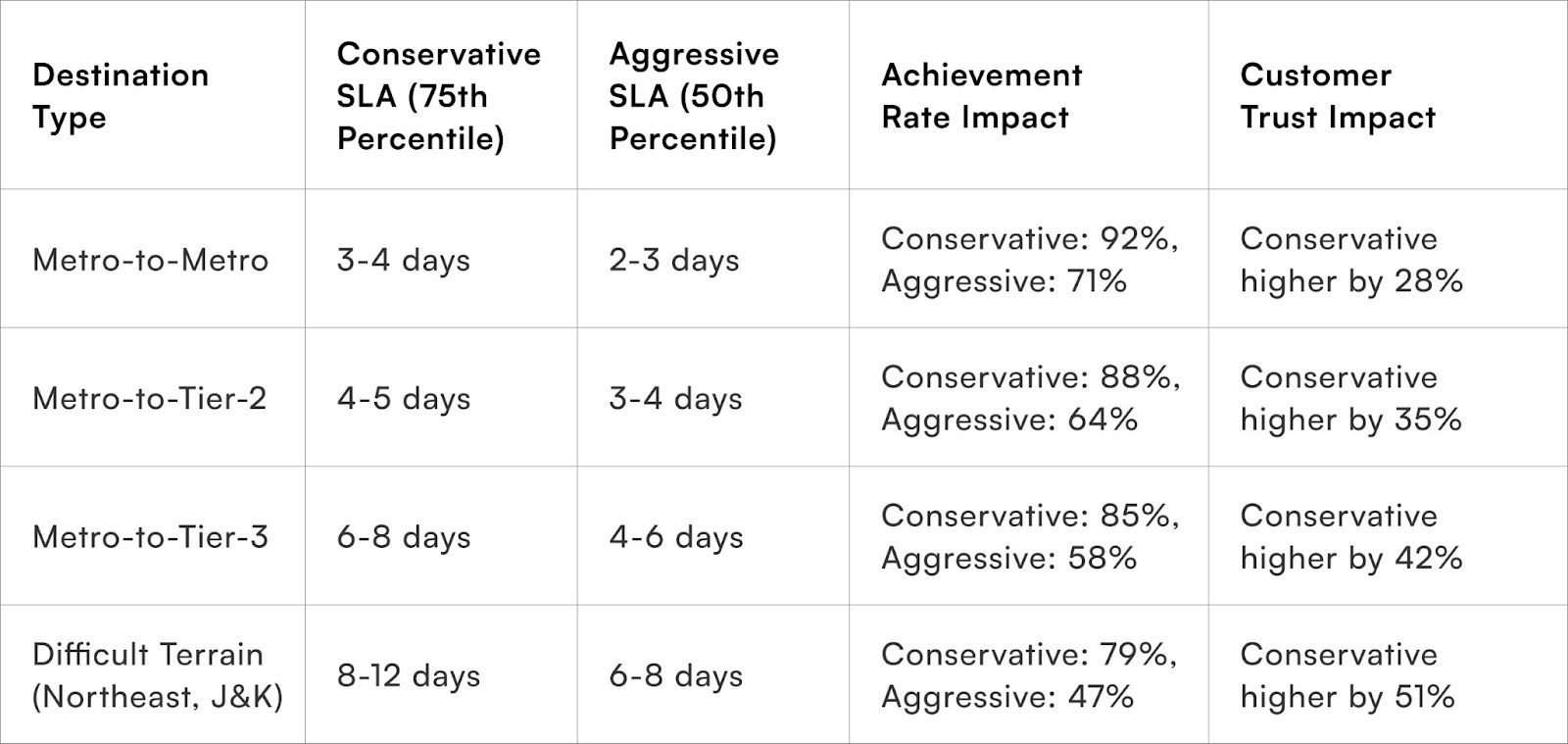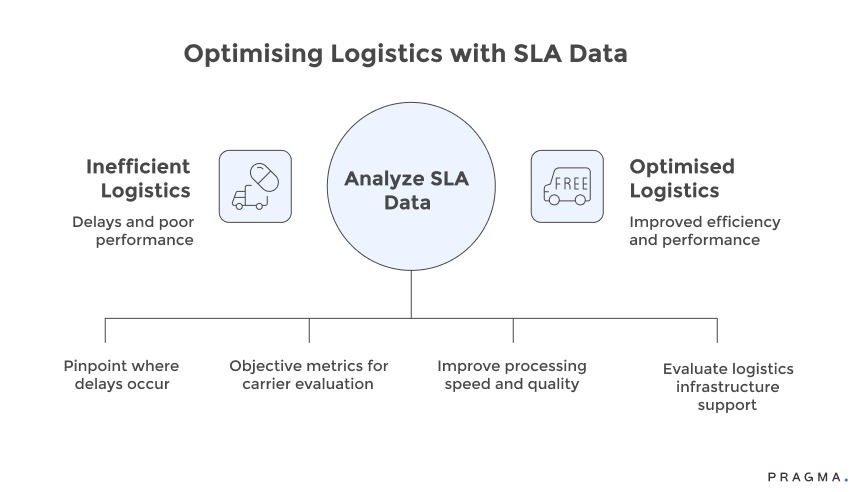Cash on Delivery (COD) remains one of the most preferred payment methods in Indian e-commerce, especially among buyers in Tier-2 and Tier-3 cities.
However, COD orders are notorious for higher return rates, payment refusals, and customer uncertainty—challenges that directly impact the brand’s bottom line and reputation. One of the critical contributors to this challenge is the lack of transparency around delivery timelines and service commitments.
Service Level Agreement (SLA) tracking offers an elegant and powerful solution. By clearly communicating delivery time expectations and proactively monitoring each stage of the order journey, brands can significantly reduce
- customer anxiety
- manage expectations
- and build trust before the order even arrives.
Real-time SLA insights enable timely interventions in case of delays, improving overall satisfaction and reducing costly Return to Origin (RTO) incidents.
In this blog, we explore How to Use SLA Tracking to Improve Customer Trust in COD Orders and what SLA tracking means for COD orders, the key metrics to monitor, and how Indian D2C brands can integrate SLA visibility into customer communications and fulfillment workflows.
With practical examples and data-backed benefits, you’ll see how SLA-led transparency turns uncertain buyers into confident customers who are more likely to complete their purchases and become loyal advocates.
What makes COD orders fundamentally different from prepaid transactions?
Payment timing creates asymmetric risk profiles that demand higher operational precision

Prepaid orders establish mutual commitment through upfront payment, creating customer investment in successful delivery. COD orders reverse this dynamic entirely, placing complete risk on brands whilst customers retain zero-friction cancellation options until handover completion.
This asymmetry manifests in behavioural patterns data reveals consistently. Prepaid customers tolerate 1-2 day delays with 78% order completion rates, demonstrating patience stemming from financial commitment. COD customers cancel at 43-56% rates when deliveries exceed promised timelines by even single days, facing no penalty for abandonment.
The economic consequences prove substantial—each COD cancellation costs brands ₹180-280 in forward logistics, return shipping, and processing overhead whilst generating zero revenue. Compounding these direct costs, cancelled COD orders damage carrier relationships as logistics partners absorb empty return legs that erode their margins.
Verification complications add further complexity. COD orders require address confirmation, phone number validation, and often explicit verbal confirmation before dispatch. These steps add 4-8 hours to processing compared to prepaid orders, compressing delivery windows when every hour matters for SLA achievement.
Analysis across 60,000+ transactions from Rajasthan and Madhya Pradesh D2C brands shows that COD order profitability hinges entirely on first delivery success rates. Orders delivered successfully on first attempt generate positive contribution margins of ₹220-380, whilst orders requiring second attempts barely break even at ₹15-45 contribution, and third attempts lose ₹140-220 per transaction when accounting for full cycle costs.
Why does SLA tracking specifically improve COD customer retention?
Measurement discipline reveals failure patterns enabling targeted interventions that rebuild trust
SLA tracking transforms vague delivery commitments into quantifiable promises brands can systematically monitor and improve. This measurement discipline proves particularly powerful for COD segments where trust deficits create heightened sensitivity to reliability signals.
Brands implementing formal SLA frameworks discover patterns invisible without structured tracking. Regional carrier performance varies dramatically—partners achieving 92% on-time delivery in Maharashtra drop to 68% in Bihar for identical service levels.
SKU characteristics influence timelines unexpectedly—lightweight items ship consistently whilst bulky products face handling delays that cascade into SLA failures.
The visibility itself drives improvement independent of specific interventions. Warehouse teams aware of SLA monitoring naturally prioritise timely dispatch knowing performance gets measured.
Carrier partners respond more urgently to escalations when brands present concrete SLA data rather than anecdotal complaints. This measurement effect generates 15-22% SLA improvements before implementing any operational changes.
Customer communication quality improves dramatically when brands track SLAs systematically. Rather than generic "order shipped" notifications, SLA-aware systems send specific delivery date commitments based on actual route performance data.
Customers receiving "Your order will arrive Thursday between 2-5 PM based on our typical delivery performance to your location" demonstrate 38% higher completion rates than those getting vague "3-4 business days" estimates.
Surat textile brands showcase these dynamics clearly. After implementing SLA tracking across their 3,500 monthly COD orders, they discovered 67% of cancellations concentrated in eight specific pincodes where carrier performance degraded systematically. Switching carriers for those zones whilst maintaining existing partners elsewhere reduced cancellation rates from 34% to 19% within 60 days, purely through measurement-driven optimisation.
How should brands establish realistic SLA commitments for COD orders?
Promise accuracy matters exponentially more than aspirational speed for trust formation

Key Strategies for Effective SLA Establishment:
Data-Driven Foundations:
The most reliable method for setting SLAs is through historical performance analysis. Brands should examine at least 90 days of delivery data, segmented by destination pincode cluster. Calculating actual delivery timelines at the 75th percentile (rather than average or best-case) provides a conservative baseline, ensuring promises remain achievable even during minor operational disruptions.
Route-Specific Customisation:
Implementing uniform national SLA standards can be detrimental. For instance, Delhi to Mumbai COD deliveries might consistently take 3-4 days, while Delhi to Gangtok could require 7-9 days due to geographical and infrastructural challenges.
Brands should tailor SLAs to specific routes, avoiding customer disappointment in difficult regions and underutilisation of capabilities in efficient corridors.
Dynamic Seasonal Adjustments:
Festival periods like Diwali, Holi, and regional festivals can strain logistics networks, extending delivery timelines by 30-50%. Smart brands proactively implement dynamic SLA adjustments tied to the calendar, automatically extending delivery promises during predictable congestion windows to prevent systematic breaches.
Case Study: Kolkata Electronics Brands
Kolkata electronics brands exemplify optimal SLA calibration through progressive refinement. They initially set a 5-day COD delivery promise across Bengal, based on carrier commitments. After tracking 60 days of actual performance and achieving 82% success, they adjusted to a 6-day promise, which resulted in a 94% success rate. Despite the slightly longer committed timelines, customer satisfaction scores improved by 31 points.
This demonstrates that reliability in meeting commitments is more impactful than sheer speed in fostering customer trust.

What operational changes emerge from disciplined SLA monitoring?
Data visibility reveals specific inefficiencies invisible through anecdotal management
Enhancing Customer Trust in COD Orders Through SLA Tracking

Key Benefits of SLA Tracking:
Identifies Processing Bottlenecks:
Timestamps reveal where delays are concentrated. For example, if 62% of SLA breaches stem from 16-24 hour order-to-dispatch gaps, the focus can be shifted to improving warehouse efficiency instead of assuming carrier problems.
Conversely, rapid internal processing followed by transit delays points to carrier performance issues that require different solutions.
Quantifies Carrier Performance:
SLA data offers objective, quantifiable metrics for carrier performance. By showing that Partner A achieves 89% on-time delivery while Partner B only manages 71% on identical routes, brands can confidently reallocate shipments.
This evidence-based approach facilitates productive carrier negotiations grounded in objective performance metrics, rather than subjective complaints.
Optimises Verification Protocols:
SLA tracking can reduce processing delays without compromising fraud prevention. Data showing that phone verification attempts between 10 AM-1 PM succeed 82% on the first call, while attempts after 6 PM require an average of 2.3 calls and achieve only a 68% connection rate, allows for adjustments in verification timing to improve processing speed while maintaining quality.
Informs Geographic Expansion Decisions:
SLA performance patterns can guide decisions regarding new regional markets. Brands can evaluate if existing logistics infrastructure supports acceptable SLA achievement before committing to acquisition spending.
For instance, discovering that current carrier networks deliver 94% SLA success in Karnataka but only 61% in Odisha informs whether an Odisha expansion requires logistics infrastructure investment before marketing activation.
Real-World Example: Jaipur Jewellery Brands
A Jaipur-based jewellery brand used SLA tracking to uncover that their premium COD orders above ₹5,000 experienced a 41% cancellation rate, compared to 23% for orders under ₹2,000. Investigation revealed that high-value orders triggered additional verification steps, adding 18-28 hours to processing.
By implementing express verification protocols for premium orders, they reduced processing time from 22 hours to 9 hours and subsequently cut cancellation rates to 27% within 45 days. This exemplifies how data-driven optimisation can significantly improve customer satisfaction and reduce losses.
Why do SLA breaches compound across customer lifecycle stages?
Initial delivery failures create skepticism that persists across subsequent purchase attempts
COD customer relationships follow particularly fragile trajectories where single SLA failures often prove terminal to brand relationships. Understanding this compounding dynamic explains why SLA discipline generates disproportionate retention improvements compared to prepaid segments.
First COD order performance predicts second purchase probability with 81% accuracy according to analysis across Indian D2C categories. Customers receiving first COD orders within promised SLAs demonstrate 47% second purchase rates within 90 days, whilst those experiencing delays or cancellations show just 9% repeat rates even when offered discounts or apologies.
The psychological impact stems from COD orders representing higher customer risk perception than prepaid purchases. Customers choosing COD often harbour initial skepticism about brand legitimacy or product quality, viewing payment-on-delivery as protection mechanism. SLA failures confirm these suspicions, validating initial reluctance whilst prepaid order delays get attributed to temporary logistics problems rather than brand unreliability.
Recovery from COD SLA breaches requires disproportionate effort compared to prepaid failures. Brands successfully recovering prepaid customer relationships through refunds and replacement shipments find identical approaches yield minimal COD customer return. The trust damage proves deeper because COD customers interpret failures as evidence their initial caution proved warranted.
Successful second COD experiences demonstrate 3.2x retention impact compared to successful second prepaid experiences. Customers overcoming initial skepticism through reliable first COD deliveries become exceptionally loyal, demonstrating 64-71% third purchase rates and 52% willingness to try prepaid payment on subsequent orders. This conversion potential makes first-COD SLA achievement extraordinarily valuable strategically.
To Wrap It Up
SLA tracking transforms COD operations from opaque cost centres into measurable systems where performance visibility drives continuous improvement and customer trust formation. The discipline of establishing realistic promises, monitoring achievement systematically, and responding decisively to breaches enables brands to convert COD's inherent challenges into competitive advantages through operational excellence that competitors treating COD as necessary friction cannot match.
This week, calculate your true SLA achievement rate by analysing the last 90 days of COD deliveries against promised timelines, then adjust customer-facing commitments to 75th percentile performance ensuring 85%+ promise keeping that rebuilds customer confidence through reliability.
Sustainable COD success requires viewing SLA achievement not as operational metric but as customer relationship foundation where every kept promise strengthens trust whilst breaches compound into permanent skepticism. Brands implementing systematic SLA tracking, route-specific promise calibration, and proactive breach communication achieve 42-55% COD customer retention compared to 18-26% retention among competitors relying on vague delivery promises and reactive problem resolution.
This retention differential translates directly into profitability as reduced acquisition dependency, higher lifetime values, and improved cash conversion through prepaid migration among trust-established customers create economic moats that purely marketing-focused competitors cannot replicate.
For D2C brands seeking to transform COD operations from necessary concessions into retention engines, Pragma's intelligent order management system provides automated SLA tracking, route-specific performance analytics, and triggered communication workflows that help brands achieve 85-92% SLA compliance rates whilst reducing COD cancellations by 35-48% through systematic promise keeping and proactive customer engagement throughout the delivery journey.

FAQs (Frequently Asked Questions On How to Use SLA Tracking to Improve Customer Trust in COD Orders)
1. How do brands balance speed versus reliability when setting COD SLAs?
Reliability trumps speed decisively for COD trust formation. Brands should establish conservative SLAs they achieve 85-90% consistently rather than aggressive promises hitting 65-70% achievement.
Customers reward predictability over aspiration—6-day promises met reliably generate 38% higher retention than 4-day promises achieved inconsistently, even though slower committed timelines might seem competitively disadvantageous.
2. What percentage of COD orders should brands expect to cancel versus complete?
Well-managed COD operations targeting appropriate customer segments achieve 70-80% completion rates with strong SLA discipline. Brands experiencing below 65% completion likely face verification problems, poor SLA communication, or inappropriate COD offering to high-risk segments.
Completion rates above 85% might indicate overly conservative customer selection missing revenue opportunities from acceptable-risk segments.
3. Should brands charge differently for COD versus prepaid to account for higher operational costs?
Economic analysis suggests COD surcharges of ₹40-80 appropriately reflect incremental costs including verification labour, higher cancellation rates, and return logistics. However, customer sensitivity varies dramatically by market tier—metro customers increasingly accept COD fees whilst tier-2/3 markets resist strongly.
Smart brands test surcharge acceptance systematically rather than assuming universal tolerance, often implementing minimum order values for free COD rather than explicit surcharges.
4. How can brands reduce COD cancellation rates beyond SLA improvements?
Verification quality proves equally important—calling customers within 2-4 hours of order placement to confirm address details, explain delivery timelines, and verify purchase intent reduces cancellations by 22-31%.
Order value optimisation matters as COD cancellations correlate inversely with purchase amount—orders under ₹800 cancel at 45-52% rates whilst orders above ₹2,500 complete at 78-84% rates. Strategic brands set COD minimums at ₹1,200-1,500 where economics prove sustainable.
5. What happens to brands that consistently miss COD SLAs in competitive markets?
Systematic SLA failures create reputation damage that compounds through negative reviews and customer acquisition cost inflation.
Brands missing SLAs on 30-40% of COD orders watch retention rates collapse to 12-18% whilst customer acquisition costs rise 40-65% as word-of-mouth turns negative and paid acquisition requires higher incentives to overcome skepticism. Recovery requires 6-12 months of consistent excellence to rebuild trust and repair review profiles.
Talk to our experts for a customised solution that can maximise your sales funnel
Book a demo



.png)
.png)